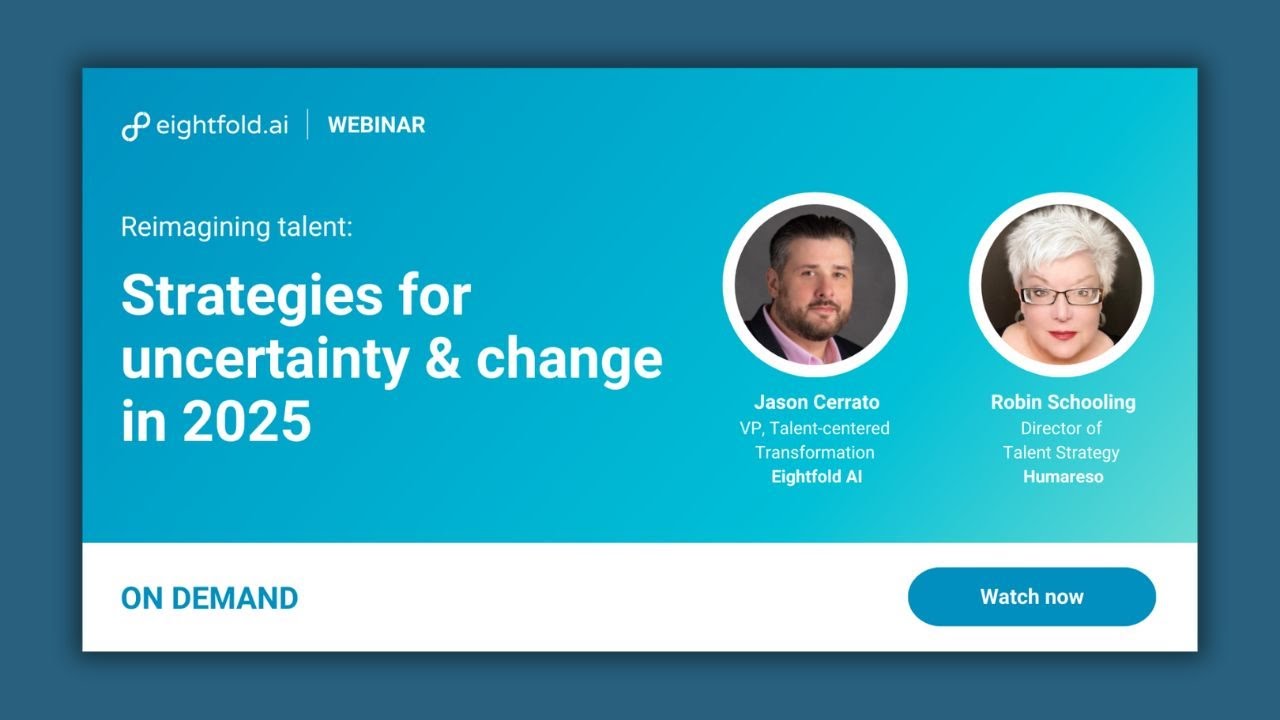- It is already a tumultuous year with an avalanche of disruptions in HR, including new technologies like agentic AI, return to office mandates, and economic uncertainty.
- AI is impacting current roles while also creating roles that have never existed, calling for entirely new structures of work and skill mixes.
- Organizations that harness new technologies to empower mobility and build a culture of learning will drive success — even in uncertain times.
If there’s one thing that’s certain about working in HR, it’s uncertainty. Just a few months into this year, and it’s already shaping up to be especially tumultuous.
For starters, we’ve seen disruptions in the U.S. labor market in terms of immigration and geopolitics. We’ve seen disruptions in learning and education. And we’ve seen disruptions in the realm of technology — especially with the emergence of agentic AI.
While those are all hot topics right now, the latter, in particular, holds a special kind of intrigue. Technology, even as it disrupts and advances, is something we can harness to address those other challenges and drive success.
Robin Schooling, Director of Insights and Innovation with Humareso, recently joined Jason Cerrato, Eightfold VP of Talent-centered Transformation, to discuss the evolving landscape of HR in 2025. They focused on areas including internal mobility, skills-based talent management, learning culture, and technology integration — all familiar areas in industry talks.
During the conversation, Schooling and Cerrato also talked about what’s quickly changing in the way we approach these conversations and the tools we’re using to meet the moment, all of which relate to AI’s evolution in the space.

Related content: In this on-demand webinar, Humareso’s Robin Schooling and Eightfold’s Jason Cerrato explore how HR leaders can align their talent strategies with transformation-focused growth initiatives.
Tech continues to reshape how HR sees talent
Research shows that HR departments are too often out of touch with the overall business and their employees.
In our talent survey, we asked HR respondents if they’re confident that employees have the tools and resources they need to grow in their roles, 75% answered yes. And yet, the majority of employees, 82%, told us they’re actively looking for a new job, with 62% saying they’re actively looking externally because they feel undervalued or are dissatisfied with internal promotion opportunities.
This misalignment between HR and employees is something Schooling is noticing in her work, too. She said she believes we’re experiencing a “perfect storm” of competing priorities.
Employees still want exciting new opportunities and professional growth, while businesses are implementing policies, including demands to return to office, despite what employees want.
“People are saying, ‘Oh my gosh, my current employer has changed some terms or conditions of my employment, and I’m no longer happy with that,’ ” Schooling said.
Additionally, there’s a general sense of economic uncertainty that started before the election and hasn’t let up.
This all points to a pressing need for HR leaders to understand how employees are thinking about their jobs long before they decide to leave, said Schooling. And that’s something that technology can help with.
By using the right tools, we can break away from the old, tried-and-true employee review cycles and schedules and receive ongoing insights into employees’ career development plans, how their work is changing, and how those changes align with or depart from their goals.
All of this informs HR teams, so they can tap into employee needs. The data can also help an organization adjust its offerings and communications, from learning programs to pulse check-ins and career conversations with hiring managers and HR managers.
Related content: Ready to recruit and retain top talent? Learn how AI is helping HR teams do that in this blog post from Eightfold Co-CEO and Co-founder Ashutosh Garg.
Tech + skills: the future of hiring
While it’s helpful to understand how employees are feeling right now, Schooling said that it’s also important to look ahead. We have a lot to contend with, she said, starting with the looming demographic shift caused by declining birth rates since the Great Recession from 2007 to 2009.
According to the Western Interstate Commission for Higher Education the number of high school graduates will peak in 2025 and then decline through 2041. Schooling said that as workplaces experience a decline in employees, they’ll need to rethink degree requirements and find new ways for technology to work alongside people and fill in the gaps..
In addition, the World Economic Forum’s 2025 Future of Jobs report affirms that in the next five years many jobs will be replaced by technology and automation. At the same time, new jobs will be created that never existed before. These may also call for entirely new structures of work and demand new skill mixes.
“We need to think about the current skills we need in our organization, or in a group of jobs, and we also need to think about the future skills we need,” Schooling said.
This future uncertainty around necessary skills underscores the need for skills-based hiring — and upskilling and reskilling workers — as we continue to adopt new technologies, especially AI.
Schooling said that future skills will likely include abilities that can’t be fully replaced by technology, including jobs that require empathy and active listening, creativity, self-awareness, and motivation.
Talent intelligence powers internal mobility
Cultivating a culture where employees can develop, move, and thrive within an organization could help solve many of these challenges.
To achieve this, many organizations have initiated programs aimed at mentoring and learning, prioritized project-based employment, and focused on increasing transparency for existing employees about internal job openings.
Yet, many haven’t gone far enough to deliver the kind of mobility that keeps employees engaged and seeking new opportunities at their current workplace.
Schooling said she believes organizations need to adopt “the Hollywood model,” which means treating work like a movie and choosing a new mix of employees to fit each film.
“Right before I make a movie, I bring together these talented people from different areas, we make our movie and then they go on and make the next movie,” she said.
She added that this approach is challenging. In many organizations, managers are reluctant to lose top employees to another department.
Schooling said that she’s seen success in industries like gaming, where casino employees can express interest in learning vastly new skills, such as a server in a restaurant opting to try out a role in security.
When shifting toward skills-based talent management, technology can serve as a connector that links employees to growth opportunities. With skills intelligence tools, you can do things like dynamic career pathing based on the skills people list in their profiles.
In HR, we know that career plans aren’t static and can’t be tracked in a spreadsheet. In the same way that employees’ profiles develop and their skills multiply, the roles within organizations evolve, too.
Talent intelligence can help an employee map out how to get from job A to job B, while also providing learning and mentoring opportunities to prepare for job C — a role that doesn’t even exist yet.
As team members become comfortable with using these dynamic tools, a culture of learning starts to organically develop. You start to get requests for education and training for what people need based on the mapping and how the connections are being drawn.
By using technology in a continuous way, they’re informing HR in real time what those needs and wants are, so that everyone can be better aligned.
Watch the webinar “Reimagining talent: Strategies for uncertainty and change in 2025” on demand now.
